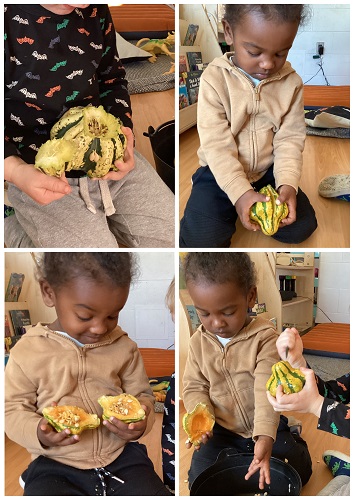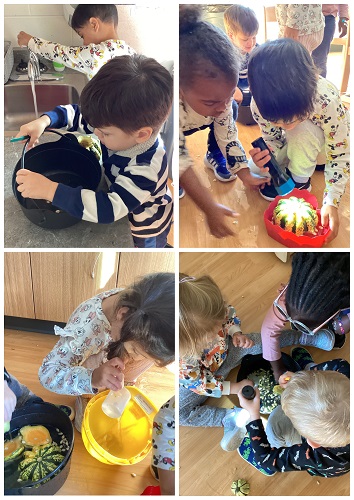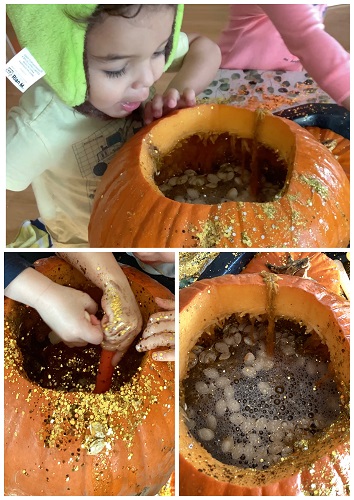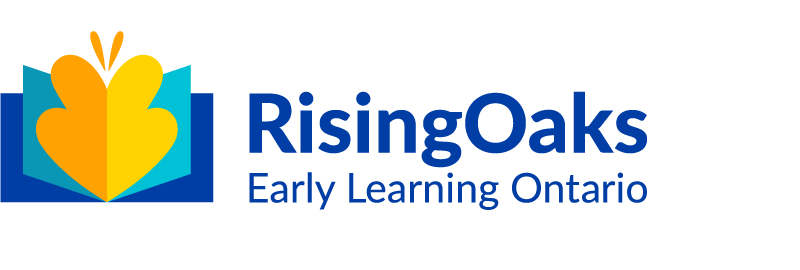The Preschool 2 children have been showing an interest in several different aspects of the Fall season. Pumpkins have been a specific topic of discussion among the children as they share and reflect on their experiences and understanding of pumpkins. They talk about pumpkins that they see at the grocery store, in the fields, at the pumpkin patch, outside of houses, and other places that they may have come across pumpkins in within their environments.
As educators and co-learners, we wondered how we could expand upon the children’s wonders and curiosities regarding pumpkins. We began to think of ways that we could design our classroom space and incorporate pumpkins into our learning environment. We added several small pumpkins and gourds to our classroom, placing them out on an open table for the children to see and explore. They immediately began to examine and make conclusions about the properties of the pumpkins. They noticed and discussed the colours, shapes, sizes, textures, and temperatures of the pumpkins. It wasn’t long before the children began to transport the pumpkins around the classroom, demonstrating their creative thinking as they came up with many meaningful ways to incorporate them into their play.
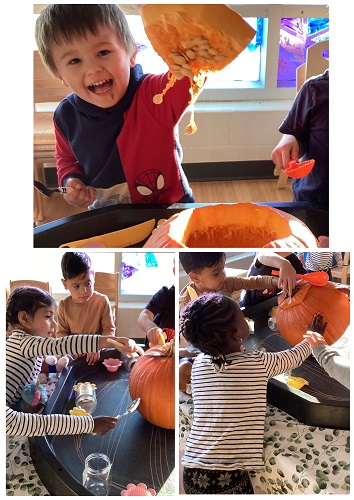
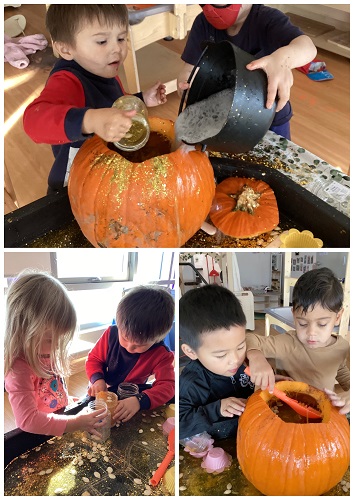
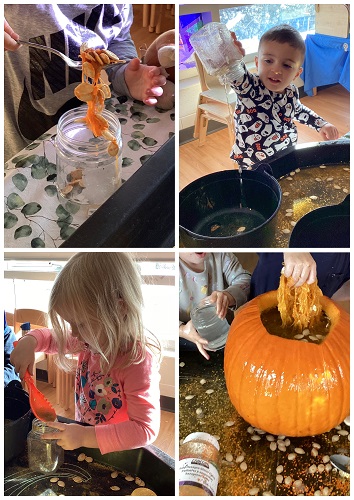
One morning, we observed two children carrying some of the pumpkins around the classroom in a large cauldron. “We are making pumpkin tea” one of the children explained. We got involved in the children’s play to challenge their thinking and extend their learning with the pumpkins. We decided to cut open the pumpkins to discover what was inside. The two children were excited and engaged as we carefully opened up the pumpkins together. Educators cut one of the pumpkins almost in half, allowing the children to use their hands to open it up fully. For another pumpkin, educators cut a hole in the top, allowing the children to remove the lid by grabbing the stem. The children demonstrated pride and wonder, observing the contents of the pumpkins as they independently opened them up. The two friends began to touch, collect, and transfer the pulp and seeds from the pumpkins into their cauldron. Many other children began to show an interest in the pumpkin action and began to join in the fun. The children took the lead in their learning as they began to gather materials from around the room to enhance their ideas and play. Some children filled cauldrons and other containers with water. Some children used dramatic play utensils to mix and stir the seeds with the pulp and water. Some children took turns passing the pumpkins around and exploring inside of them. Some children pretended to make various food creations with the substances such as teas, cupcakes, and soups. One child noticed the water that spilled on the floor and retrieved a cloth to help clean it up. Some children used flashlights to inspect their work. Each child had a unique learning experience with the pumpkins to support their individual interests, abilities, and curiosities.
We reflected on the children’s actions with the pumpkins, and decided to further enhance their pumpkin knowledge by bringing in a large pumpkin for us to carve. We based the set up of this pumpkin provocation on the children’s interest in dissecting the smaller pumpkins, integrating them into their imaginative play, and transforming it into a sensory experience. We added materials to support and extend this type of play such as scoops, cups, spoons, cupcake liners, and the cauldrons. Before we could even cut into the pumpkin, the children were already brainstorming ways that they could get into it themselves! A small team of children gathered around the table, utilizing tools found around the classroom to help them cut the pumpkin open. One child grabbed a wooden hammer, while another child grabbed a wooden saw. One child found a plastic play dough knife. A handful of children grabbed the spoons directly from the pumpkin station. The crew was excited when an educator helped them to cut open the top of the pumpkin with a real knife. The children worked together to get the top off of the pumpkin, and from there they dove deep into rich, hands on learning. Children began filling containers with pulp and seeds. One of the children said they needed water for their play. What happened next was wonderful to observe, as the children began to engage in collaborative play as they worked together to collect, carry, pour, and fill the large pumpkin with water from the sink. They had many creative ideas as they added sand from the sensory bin, glitter from the art area, and soap from the sink to their group creation. Many discoveries were made as they worked towards their collective goal of filling the pumpkin. There were many individual side experiments happening as well. Learning opportunities unfolded as the children explored concepts such as empty and full, buoyancy, weight, and volume. Developmental skills such as cooperation, communication, vocabulary, problem solving, creativity, and cognitive thinking were enhanced through many aspects of this experience.
We are excited to see how we can continue to foster the children’s growing knowledge and understanding of pumpkins and other seasonal concepts in the coming weeks of Fall.
